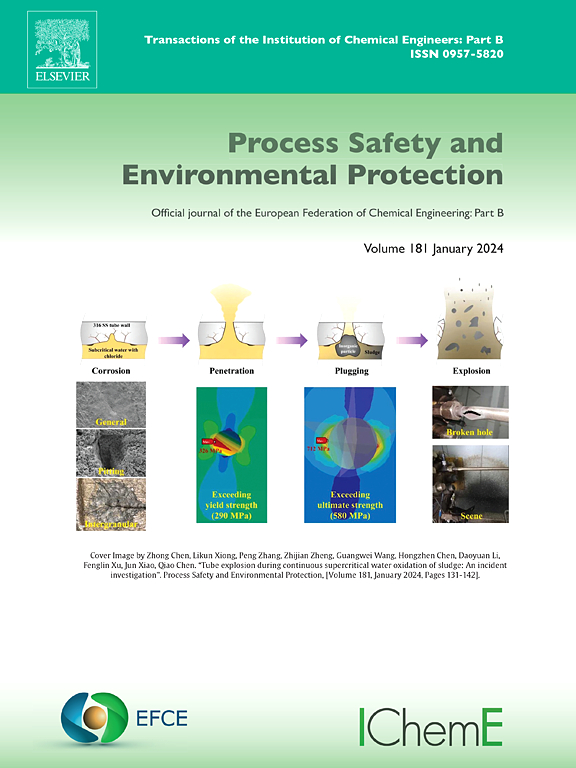Electrocoagulation as a stand-alone and hybrid strategy for medium-density fibreboard wastewater treatment: Performance, energy consumption and radical oxidant effects
IF 6.9
2区 环境科学与生态学
Q1 ENGINEERING, CHEMICAL
引用次数: 0
Abstract
The aim of this study was to investigate the electrocoagulation (EC) treatment of medium density fibreboard (MDF) effluent and to improve its performance by integrating advanced oxidation processes (AOPs) using hydrogen peroxide (HP), peroxymonosulphate (PMS) and peroxydisulphate (PDS). Initially, different electrode materials and configurations were tested and the Fe-Al electrode pair demonstrated superior COD removal performance. Operating parameters including pH, current, electrolysis time, inter-electrode distance and electrolyte type/concentration were optimized. The optimum conditions were determined to be pH 7.4, 1.5 A current, 50 min electrolysis time, 0.02 M NaCl and 2 cm electrode spacing, resulting in 80.8 % COD, > 99 % colour and 93.4 % tannin/lignin removal. Subsequent experiments combining EC with HP, PMS and PDS at different dosages showed that EC-HP slightly improved COD removal (84.9 %) compared to EC alone, while EC-PMS (79.3 %) and EC-PDS (77.7 %) provided marginal or no improvement. All treatments achieved over 99 % colour removal, confirming the high efficiency of EC and EC-AOPs for the treatment of refractory organic pollutants in MDF effluents. The kinetics of COD removal for all treatment processes followed a pseudo-first-order model. The calculated rate constants were –0.0104 min⁻¹ for EC, –0.0204 min⁻¹ for EC-HP, –0.0082 min⁻¹ for EC-PMS and –0.0049 min⁻¹ for EC-PDS. The results also demonstrate the applicability of paper and pulp effluent studies for comparative evaluation due to the similar characteristics of these effluents. Among all the processes, the lowest specific energy consumption (SEC) was observed for EC-PMS treatment (38.75 kWh/m³), significantly lower than for EC alone (84.37 kWh/m³), EC-HP (80.00 kWh/m³) and EC-PDS (77.81 kWh/m³). This reduction was attributed to the increased conductivity caused by PMS (10.55 mS/cm), which allowed more efficient energy use compared to EC (4.09 mS/cm), EC-HP (3.69 mS/cm) and EC-PDS (4.85 mS/cm).
电絮凝作为中密度纤维板废水处理的独立和混合策略:性能、能耗和自由基氧化效应
本研究的目的是研究电絮凝(EC)处理中密度纤维板(MDF)废水,并通过使用过氧化氢(HP)、过氧单硫酸盐(PMS)和过氧二硫酸盐(PDS)整合高级氧化工艺(AOPs)来改善其性能。最初,测试了不同的电极材料和配置,Fe-Al电极对表现出优异的COD去除性能。对pH、电流、电解时间、电极间距、电解液类型/浓度等操作参数进行了优化。最佳工艺条件为pH 7.4、1.5 A电流、50 min电解时间、0.02 M NaCl和2 cm电极间距,COD去除率为80.8 %,显色率为 99 %,单宁/木质素去除率为93.4 %。随后将EC与不同剂量的HP、PMS和PDS联合使用的实验表明,与EC单独使用相比,EC-HP略微提高了COD去除率(84.9 %),而EC-PMS(79.3% %)和EC-PDS(77.7 %)的去除率微乎其微或没有提高。所有处理的去色率均超过99% %,证实了EC和EC- aops处理中密度纤维板废水中难降解有机污染物的高效率。所有处理过程的COD去除动力学都遵循伪一阶模型。计算出的速率常数为:EC -0.0104 min⁻¹ ,EC- hp -0.0204 min⁻¹ ,EC- pms -0.0082 min⁻¹ ,EC- pds -0.0049 min⁻¹ 。结果还表明,由于造纸和纸浆废水的特性相似,因此对它们进行比较评价的适用性。在所有工艺中,EC- pms处理的比能耗(SEC)最低(38.75 kWh/m³),显著低于EC单独处理(84.37 kWh/m³)、EC- hp处理(80.00 kWh/m³)和EC- pds处理(77.81 kWh/m³)。这种降低是由于PMS (10.55 mS/cm)增加了电导率,与EC (4.09 mS/cm)、EC- hp (3.69 mS/cm)和EC- pds (4.85 mS/cm)相比,PMS可以更有效地利用能源。
本文章由计算机程序翻译,如有差异,请以英文原文为准。
求助全文
约1分钟内获得全文
求助全文
来源期刊

Process Safety and Environmental Protection
环境科学-工程:化工
CiteScore
11.40
自引率
15.40%
发文量
929
审稿时长
8.0 months
期刊介绍:
The Process Safety and Environmental Protection (PSEP) journal is a leading international publication that focuses on the publication of high-quality, original research papers in the field of engineering, specifically those related to the safety of industrial processes and environmental protection. The journal encourages submissions that present new developments in safety and environmental aspects, particularly those that show how research findings can be applied in process engineering design and practice.
PSEP is particularly interested in research that brings fresh perspectives to established engineering principles, identifies unsolved problems, or suggests directions for future research. The journal also values contributions that push the boundaries of traditional engineering and welcomes multidisciplinary papers.
PSEP's articles are abstracted and indexed by a range of databases and services, which helps to ensure that the journal's research is accessible and recognized in the academic and professional communities. These databases include ANTE, Chemical Abstracts, Chemical Hazards in Industry, Current Contents, Elsevier Engineering Information database, Pascal Francis, Web of Science, Scopus, Engineering Information Database EnCompass LIT (Elsevier), and INSPEC. This wide coverage facilitates the dissemination of the journal's content to a global audience interested in process safety and environmental engineering.
 求助内容:
求助内容: 应助结果提醒方式:
应助结果提醒方式:


